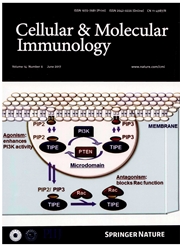

 中文摘要:
中文摘要:
主要 histocompatibility 建筑群(MHC ) 一级信息为在 HIV 种痘和生物医学的模型理解有免疫力的回答的变化是重要的。在这研究, 9 Mamu -- A 和 13 Mamu-B 等位基因从 10 只中国起源的罗猴猕猴的 cDNA 产品被识别。除了被其它报导了的二等位基因,八是新奇的, 12 扩大了在 GenBank 是可得到的部分序列。MHC 一级抗原的另外的信息可能对在人的疾病研究的中国猕猴的可获得性有益。而且,领先的肽的多型性和在 α1 领域的自然漂亮受体识别主题两个都暗示那 Mamu -- A 和 Mamu-B 分子力量玩在自然漂亮房间的天生的有免疫力的回答给角色调音。
 英文摘要:
英文摘要:
Major histocompatibility complex (MHC) class I information is vital for understanding variance of immune responses in HIV vaccination and biomedical models. In this study, 9 Mamu-A and 13 Mamu-B alleles were identified from the cDNA products of 10 Chinese-origin rhesus macaques. Except for two alleles that had been reported by others, eight were novel and twelve extended the partial sequences that are available in GenBank. The additional information of MHC class I antigens might be beneficial to the availability of Chinese macaques in human disease studies. Furthermore, the polymorphism of leading peptides and the natural killer receptor recognition motifs in al domain both implies that Mamu.A and Mamu-B molecules might play key roles in innate immune responses of natural killer cells.
 同期刊论文项目
同期刊论文项目
 同项目期刊论文
同项目期刊论文
 Preparation and identification of HLA-A*1101 tetramer loading with human cytomegalovirus pp65 antige
Preparation and identification of HLA-A*1101 tetramer loading with human cytomegalovirus pp65 antige High level expression of HLA-A*0203-BSP fusion protein in Escherichia coli and construction of solub
High level expression of HLA-A*0203-BSP fusion protein in Escherichia coli and construction of solub Enhancement of binding activity of soluble human CD40 to CD40 ligand through incorporation of an iso
Enhancement of binding activity of soluble human CD40 to CD40 ligand through incorporation of an iso CD8+ T cells specific for both persistent and non-persistent viruses display distinct differentiatio
CD8+ T cells specific for both persistent and non-persistent viruses display distinct differentiatio High frequencies cytomegalovirus pp65495-503-specific CD8+ T cells in healthy young and elderly Chin
High frequencies cytomegalovirus pp65495-503-specific CD8+ T cells in healthy young and elderly Chin Preparation of H-2Db tetramer and its application in enumerating the CD8+ T cells specific for lymph
Preparation of H-2Db tetramer and its application in enumerating the CD8+ T cells specific for lymph Integrated risk assessment of complex disaster system based on a non-linear information dynamics mod
Integrated risk assessment of complex disaster system based on a non-linear information dynamics mod 期刊信息
期刊信息
